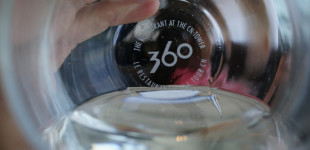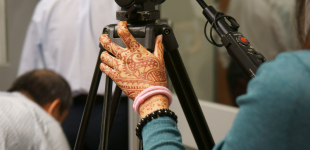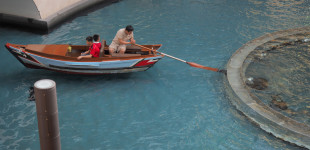I’ve been shooting with Sony’s Nex 5R for nearly three years, and in that time, I’ve accumulated six lenses for the system. But when my camera started malfunctioning during my trip to Toronto, I decided to buy an Olympus EM5 Mark II instead of the Sony Alpha 6000.
Keep in mind that the S$4000 in Sony lenses I own are not compatible with Olympus bodies, so this switch was a very big deal. If you intend to buy you first mirrorless APSC or micro 4/3 camera, here’s why I made the switch.
My Shooting Needs
I shoot mainly for the web. In addition to shooting for my blog and social media accounts, I also occasionally cover events at Nanyang Polytechnic.
I do not produce any large prints, or shoot any commercial/publication work.
So I prefer a lightweight, high-quality camera system that is easy to carry around. As I’ve become more experienced, I’ve also come to appreciate “Pro-level” features, including additional dials, function buttons, weather sealing and a great lens and accessory ecosystem.
And this brings me to my first point.
Lens Selection for Sony E-Mount Cameras Needs Serious Work
When comparing Sony’s Alpha system to Panasonic and Olympus’s Micro Four Thirds (m43) system, lens selection is always cited as one of the key differences. But when you buy into any camera system, ‘lens selection’ is more than just another bullet point in the pros and cons list; it can make or break your entire experience.
That is also why Canon and Nikon continue to rule the full-frame DSLR market. Both companies have a phenomenal range of lenses that covers everything from pro-grade telephoto lenses, to cheaper, consumer-friendly lenses.
It’s a pity that neither Canon nor Nikon have taken the mirrorless market seriously, unlike Olympus, which has replicated Nikon’s Holy Trinity with its critically-acclaimed Pro series of lenses.
The ‘Holy Trinity’ refers to a trio of lenses produced by Nikon – the 14-24mm f2.8, 24-70mm f2.8 and 70-200mm f2.8. Olympus has produced equivalent lenses in its Pro series of lenses with the M. Zuiko Digital 7-14mm f2.8, M. Zuiko Digital 12-40mm f2.8 and M. Zuiko Digital 40-150mm f2.8.
This virtually covers the entire shooting range for most photographers.
Sony does not have the equivalent glass. Sure, they have lenses that cover the same range, but they aren’t as fast and, I have serious doubts about its image quality, specifically for their zoom lenses.
This is a terrible pity, because from my experience, with the right glass, Sony’s cameras are able to produce fantastic images and I was very happy with the photos I took with the Zeiss Touit 32mm f/1.8 lens during my Toronto vacation.
Sample photos from the Zeiss Touit 32mm f/1.8
Sony has great prime lenses, but so does every major interchangeable lens system. Its penultimate weakness is its lack of fast, high-quality telephoto zoom lenses.
I own the Sony Carl Zeiss 16-70 (SEL1670Z) telephoto lens, and though it is better than the kit lens, it is not as good as Olympus’s 12-40 Pro, which is weather-sealed, equipped with the super useful focus clutch, and is much sharper across the entire frame. Both lenses are similar in price, and even though Sony’s lens offers a bit more range, I feel like I am getting a lot more with Olympus.
Sample photos from the Sony Carl Zeiss 16-70 (SEL1670Z)
The Olympus 12-40 simply produces better, sharper overall images. The additional pro-grade features are just icing on an already impressive cake! I also find it easier to change aspect ratios using the Olympus, making it easier for me to take square (1:1) photos for Instagram. The silent shutter on the Olympus EM5 II is also crucial for when I need to take photos of media events that involves audio/video recording.
Sample photos from the Olympus M Zuiko Digital ED 12-40mm f/2.8 Pro
The m43 system from Panasonic and Olympus has an impressive range of lenses to cater to both the hobbyist and serious photographer. It has often been described as an “embarrassment of riches”, and I tend to agree.
Micro 4/3 is Stable. Sony is Fickle.
Sony customers have it rough. How many formats has Sony created and abandoned? Betamax. Memory stick. MiniDisc. Vaio. Sony has an obligation to support customers who have been loyal to their brand. But Sony has a terrible habit of abandoned promising, but ultimately half-baked product lines.
At least when Apple changes formats, it leaves customers with a rich ecosystem of accessories that will probably outlast the lifespan of the product. Just look at the amount of accessories you can still buy for Apple’s antiquated 30 pin connector.
The same cannot be said about Sony’s A mount system, which has barely seen any new lenses or bodies since Sony launched the FE system. Things look bleak for A mount users, and it is starting to look bleak for E mount users too.
Sony’s roadmap does not have a single, APSC-dedicated E mount lens. So much for hoping that Sony would make its own version of the Holy Trinity.
And even though FE lenses can be mounted on E mount bodies, the crop factor results in a different focal length. FE lenses are also engineered and designed for bigger sensors, making them inherently bigger and defeating the purpose of investing in a compact and lightweight system.
For m43, you have two companies support one system, giving you much more choice.
If you don’t like Olympus, you could always buy Panasonic’s equivalent lenses, including their own version of the Holy Trinity and some very nice Leica-licensed lenses.
Imagine if Nikon and Canon put aside their differences, and agreed to support one common lens mount. It’s kind of like that.
Sony has already abandoned A mount users, and it looks like E mount users are next. With Sony, there’s a risk that they may reserve the good stuff for another system, if they even make it at all. There is no such risk with Panasonic and Olympus – this is their best system.
Durability and Customer Service
My Sony Nex 5R died after 3 years of use. And even though it chose the worst possible time to die – while I was on vacation – it had seen a reasonable amount of usage.
But when I sent it in for repair at the Sony Centre at Nex, I was outraged that the Sony wanted to charge me simply to look at it. I expressed my incredulity to the customer service representative, but I told them to proceed anyway.
Barely one month prior, Apple Canada looked at my father’s out-of-warranty 15 inch MacBook Pro for free, and they also waived the S$700 repair bill.
I’m not expecting Sony to waive any fees for repair/parts, but an examination fee? Seriously? To be fair, I do not know if this is common practice for other camera manufacturers in Singapore.
But to Sony’s credit, their technician called me several days later and informed me that the shutter release’s circuit board was faulty. I told him to proceed with the repair and clarified the total amount due. To my surprise, he informed me that by choosing to proceed with the repair, Sony would waive the examination fee! The customer service representative at Nex should have stated this upfront.
Unlike Sony, Olympus cameras appear much more durable; at least on paper.
In practice, the front wheel on the grip (HLD-8G) of my EM5 Mk II started malfunctioning less than one month after I purchased it. To make matters worse, it started malfunctioning while I was attending a hands-on photography course.
I contacted Olympus Singapore and expressed my disappointment and how easily and quickly the grip failed after I invested over S$2,500 in this system. On the same day, Olympus called me to make arrangements for a courier to collect the faulty grip and one week later, they replaced it with another one. As a gesture of goodwill, they waived the courier fees (S$10 per delivery at the time of this writing).
This is an example of excellent service recovery by Olympus Singapore – they resolved my issue in a prompt, decisive and satisfactory manner. But I was ultimately left with a very poor impression of Olympus’s quality control for its accessories. I hope its lenses and camera bodies do better!
E-Mount is Good. Micro 4/3 is Amazing.
Sony is the world’s leading manufacturer of camera sensors, which can be found in everything from the iPhone to Nikon and Canon’s DSLRs. Even some of Olympus’ image sensors are made by Sony.
But from my experience, there are other factors that go into making a great image, like the image processor, the photographer, and of course, good lenses.
That’s why the iPhone tends to take better photos than Xperia phones.
From my time with the Nex 5R, I’ve noticed that the camera can take some stunning images with the right glass. But with Sony’s history of abandoning systems before realizing its full potential, I have stopped waiting for fast, high-quality zoom lenses for the E mount system.
I can only describe the Sony Carl Zeiss 16-70 (SEL1670Z) as ‘good’ and nothing more. The equivalent lens I have from Olympus costs about the same, and it has far superior build and image quality.
To be fair, neither Nikon nor Canon has the Holy Trinity equivalent of native lenses for their APSC line-up either, but they have a much wider selection of glass that is probably of higher quality.
When I bought my Sony Nex 5R three years ago, it was Sony’s next big thing, and the future looked bright. But three years have passed, and Sony has yet to produce stellar zoom lens for popular, and commonly used focal lengths, and the E mount lens roadmap is virtually non-existent.
Buyers can consider investing in Sony’s Full-Frame FE mount system, but it has an anaemic lens selection, and judging by Sony’s past performance, an uncertain future. Also, if you intend to carry around huge full-frame lenses and bodies, Canon or Nikon may be a better investment.
In the future, I may buy a deeply-discounted, oft-rumoured Sony a7000 (or a6000 successor) simply to continue using my library of E mount lenses. But to anyone else looking to invest in a light-weight, high-quality mirrorless system, I recommend considering micro 4/3 instead.
Thinking about buying some mirrorless gear?
If you found this editorial helpful and you would like to help me out, you can do some shopping at Amazon with my referral link, or any of the hyperlinks in the article. It doesn’t cost you anything extra, and the referral from Amazon helps me produce additional content for readers like yourself.









































Canon don’t use Sony sensor for their DSLR lineup, only for some compact camera. Their in-house sensors kind a suck compared to other founder, that the reason why Canon body score poorly on DXO. Too bad because Canon lenses are pretty good. I agree with your argumentation, I changed from Canon APS-C to Olympus for the same reason : lenses selection. Now I have an EM1 with the three 2.8 pro zoom, and man that lenses are just stunning.
Agreed 100% with your article. I come from the Canon APS-C camp, 70D and SL1 where my last ones, always deciding which to carry, but with the SL1 and the 40mm pancake I discovered the magic of compact. By then I had already ditched RAW and was back to shooting JPEG, I felt liberated and photography started to be fun again. After carefully reviewing my real needs, once again, I discovered the Olympus OM-D and the PRO trinity lenses. Long story short, sold all my gear (the 2 Canons and 4 lenses) and went ahead and bought the E-M5 II Pro Kit. Absolutely the best decision ever. Love the system size, build quality, optical performance. Olympus’ straight out of camera JPEGs are simply outstanding. The much criticized interface is pretty straightforward once you put some time into it.
There are a few valid reasons to use full frame, but none apply to me. However I see no ‘raison d’être’ for APS-C, it’s neither compact, nor a true standard.
“There are a few valid reasons to use full frame, but none apply to me. However I see no ‘raison d’être’ for APS-C, it’s neither compact, nor a true standard.”
Well put. That is a very succinct way to phrase it. I haven’t really thought about it that way before. But to be fair, I think FujiFilm’s X Series of camera’s in an exception to this rule.
True that. The Fuji X-T1 was my other consideration but the Olympus lenses line up pulled me into OM-D.
It looks like we are of the same mind on this matter. I was also pulled in by Olympus lenses, and I appreciated the additional lens selection from Panasonic, including their Leica-branded lenses. If I weren’t shooting M43, and was looking for a sub full-frame format I would probably go with a Fuji.